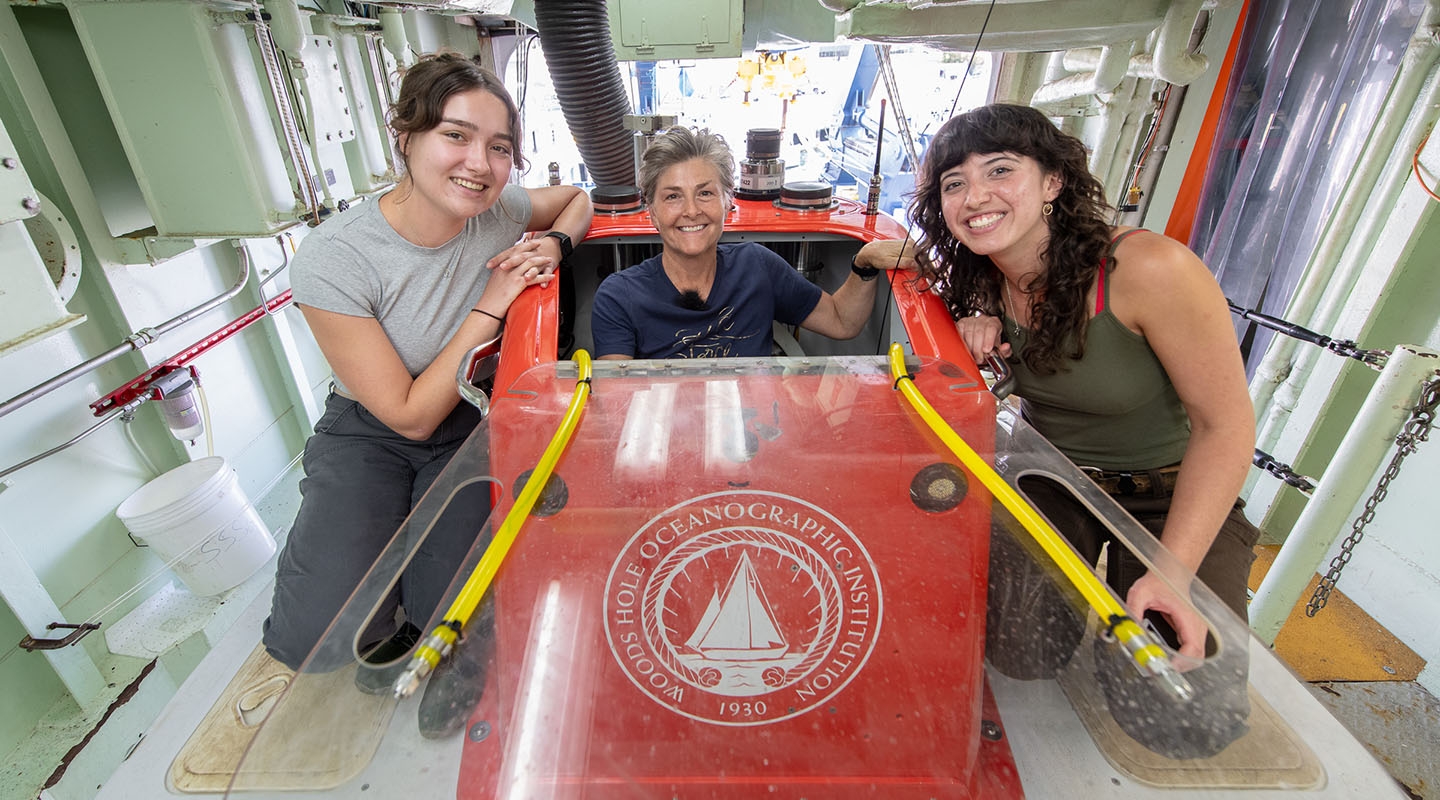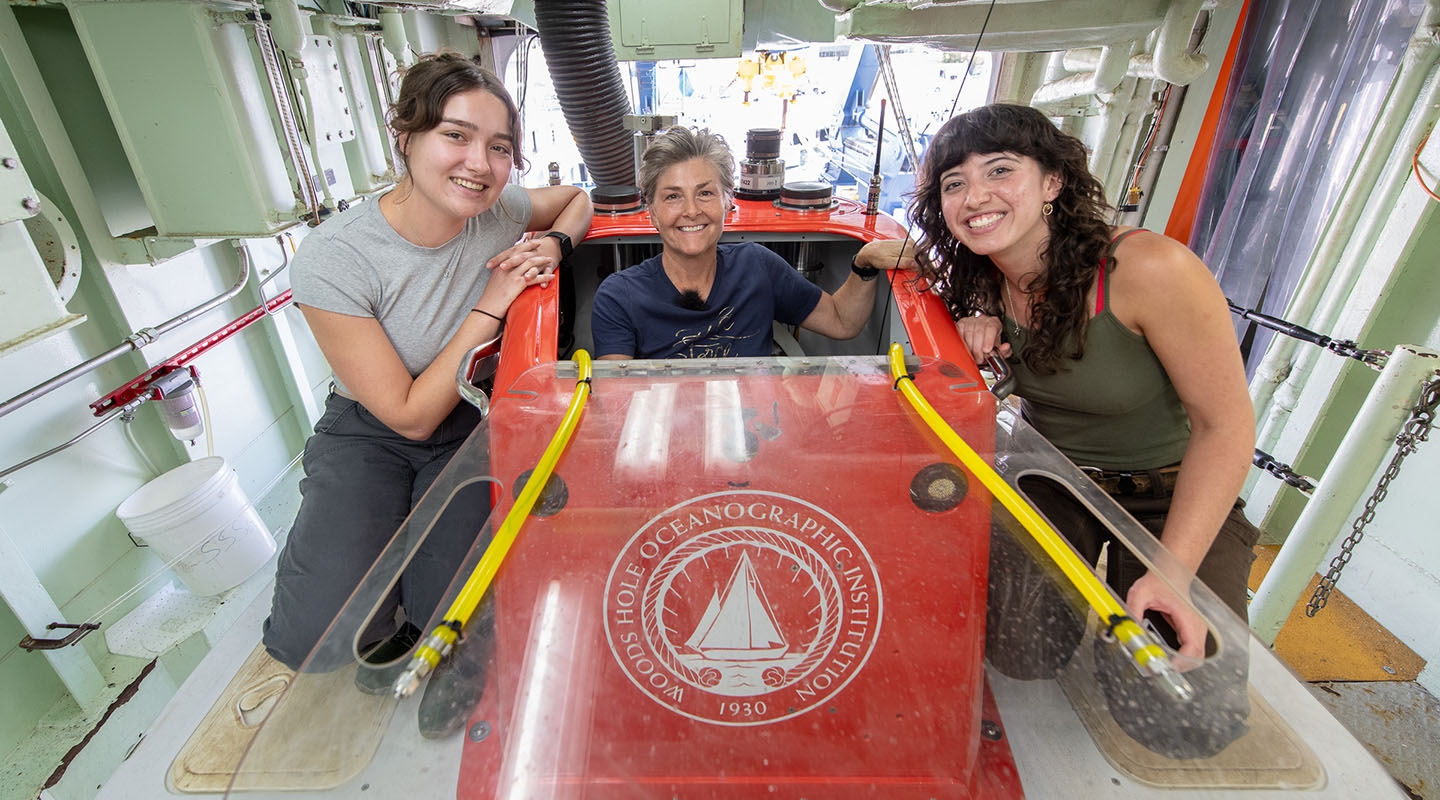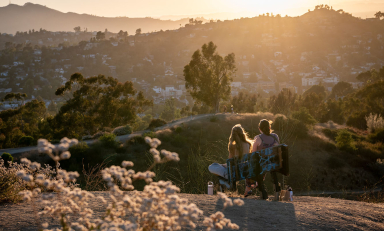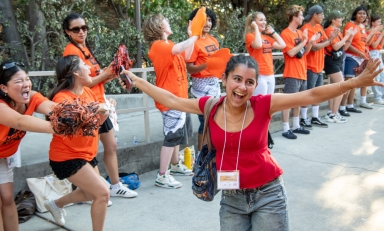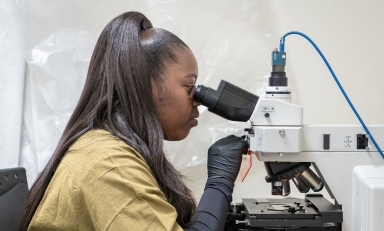Professor of Biology Shana Goffredi and two Occidental College students joined a two-week expedition on the Atlantis research vessel, which utilizes the deep-sea submersible ALVIN.
Getting to witness the launching of the deep-sea submersible off the research ship each morning was a memorable highlight for Ruby Siehl ’24. The crew and submersible technicians had the whole process down to a science, she says.
“Watching the swimmers ride the submersible into the water, jump off, and finalize everything before letting ALVIN sink below the surface was so incredible,” said Siehl, a 2023-24 Science Scholar . “Even though the general attitude is one of safety and attentiveness, everyone is still having a lot of fun with what they’re doing.”
Professor of Biology Shana Goffredi has used submersibles, both robotic and human-occupied, for almost 25 years as part of her work in marine biology. She calls them essential for her research program.
“There is really no substitute for seeing the ecosystems with your own eyes, making observations, conducting seafloor experiments and selecting samples,” she says.
Goffredi recently had the opportunity to harness this technology along with two of her students when they embarked on a two-week oceanic expedition on the R/V Atlantis, an ocean research ship owned by the U.S. Navy and operated by the Woods Hole Oceanographic Institution. It is one of the most sophisticated research vessels in use today. It is specifically outfitted for launching the human-occupied submersible ALVIN, which allows two scientists at a time to observe, gather data and explore the ocean to depths reaching 6,000 meters.
Siehl and Bianca Dal Bó ’24 joined Goffredi and a team of 22 other scientists to conduct shipboard experiments, take photographs and preserve specimens off the coast of Southern California. The Oxy students worked alongside graduate students from Caltech, UCLA and Scripps Institution of Oceanography.
“Working in the same spaces as graduate students and postdocs allowed me to observe how they conduct research, which inspired me to emulate their work styles and learn from their independence as I continue with my own research,” Siehl says.
The expedition, funded by the National Science Foundation, was led by an all-female team of four scientists, including Goffredi. With a port in San Diego as the homebase, the ship mobilized for departure July 14-15 and returned to port July 30.
The expedition’s research explored the role of large and small deep-sea organisms in determining levels and impacts of methane, a potent greenhouse gas, on Pacific continental margins. Its focus is the deep ocean methanosphere, made up of the microbial communities that consume methane, the animals that feed on or form symbiotic relationships with methane-consuming microbes, and the transitional animal communities that get energy from methane indirectly.
Days on the vessel were long, often running from 6 a.m. to midnight, as the scientists made the most of their time. Siehl observed how the other scientists treated their samples and experiments with immense care while also working as productively as possible.
“This taught me about balancing efficiency with vigilance when working in a research environment,” Siehl says, “and I know this will be of great benefit to me as I continue my research throughout my final year at Oxy.”
Dal Bó, also a 2023-24 Science Scholar , researches deep-sea invertebrates—specifically sponges, sea spiders, worms and snails—that inhabit the diverse ecosystem of the Del Mar methane seep off the coast of Southern California. Using molecular analyses, microscopy techniques and isotopic data, she aims to identify the microbes that form intimate partnerships with these animals and how they may be facilitating their unusual nutritional lifestyle.
In addition to the many unforgettable moments—the whale at sunset, getting to sit inside the submersible and learn about everything in it from one of the engineers, dissecting under the microscope while on a moving ship and retrievals every day—Dal Bó says another huge highlight was new discoveries that happened as the voyage progressed.
“The expedition involved many research groups from other institutions, which meant that I learned about deep sea oceanography, microbiology, geology and chemistry from experts in the field,” Dal Bó says. “In these ways, this voyage gave me unparalleled access and opportunity to scientifically further my project.”
The expedition’s research will ultimately improve scientific understanding of methane’s contribution to deep-sea diversity and ecosystem function, which has implications for management and conservation actions in United States waters. And according to Goffredi, the work holds vast potential for discovery.
“I continue to be amazed by how much of the seafloor remains unexplored,” she says. “Even within 12 miles of one of the busiest coastlines in the U.S., we discovered a brand-new methane seep at 800 meters water depth, with unusual animal communities. To be physically immersed in their world, seeing it with my own eyes, is an incredible opportunity, but it also comes with great responsibility to convey how much these diverse seafloor habitats are worth caring for and protecting.”
Follow along the journey and see additional photos on Instagram.

